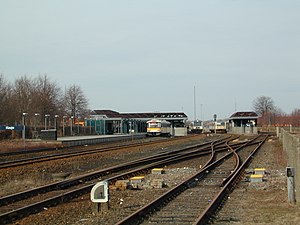Roskilde – Næstved railway line
| Roskilde – Næstved | |||||||||||||||||||||||||||||||||||||||||||||||||||||||||||||||||||||||||||||||||||||||||||||||||||||||||||||||||
|---|---|---|---|---|---|---|---|---|---|---|---|---|---|---|---|---|---|---|---|---|---|---|---|---|---|---|---|---|---|---|---|---|---|---|---|---|---|---|---|---|---|---|---|---|---|---|---|---|---|---|---|---|---|---|---|---|---|---|---|---|---|---|---|---|---|---|---|---|---|---|---|---|---|---|---|---|---|---|---|---|---|---|---|---|---|---|---|---|---|---|---|---|---|---|---|---|---|---|---|---|---|---|---|---|---|---|---|---|---|---|---|---|---|
|
Køge train station
| |||||||||||||||||||||||||||||||||||||||||||||||||||||||||||||||||||||||||||||||||||||||||||||||||||||||||||||||||
| Route number : | Banedanmark 4 | ||||||||||||||||||||||||||||||||||||||||||||||||||||||||||||||||||||||||||||||||||||||||||||||||||||||||||||||||
| Course book range : | 51 | ||||||||||||||||||||||||||||||||||||||||||||||||||||||||||||||||||||||||||||||||||||||||||||||||||||||||||||||||
| Route length: | 61.4 km | ||||||||||||||||||||||||||||||||||||||||||||||||||||||||||||||||||||||||||||||||||||||||||||||||||||||||||||||||
| Gauge : | 1435 mm ( standard gauge ) | ||||||||||||||||||||||||||||||||||||||||||||||||||||||||||||||||||||||||||||||||||||||||||||||||||||||||||||||||
| Top speed: | 120 km / h | ||||||||||||||||||||||||||||||||||||||||||||||||||||||||||||||||||||||||||||||||||||||||||||||||||||||||||||||||
|
|||||||||||||||||||||||||||||||||||||||||||||||||||||||||||||||||||||||||||||||||||||||||||||||||||||||||||||||||
The Roskilde – Næstved railway is a single-track railway line in Denmark . It is also known as Lille Syd .
history
On October 4, 1870, the line from Roskilde via Køge to Næstved and on to Masnedsund near Vordingborg was opened.
Until the opening of the connection from Ringsted to Næstved in 1924, all rail traffic from Copenhagen to the island of Falster ran over this route . This also included long-distance traffic to Gedser , from where there was a ferry connection to Germany . Long-distance traffic has been via Ringsted since 1924 and the Roskilde – Næstved line is only used for local traffic.
1925 was Militærsporet shut down that from 1892 about prior to the current breakpoint Næstved North connect to the newly built railway Slagelse-Næstved produced that a change of locomotive in the former railhead made Næstved superfluous.
Næstved harbor railway
As the first port railway in Denmark, a connection between the paper mill Magle Mølle and Næstved station was put into operation on April 1, 1874 as a horse-drawn tram . Around 1900 there were additional siding to the port at Suså , where goods could be loaded onto barges. Shunting locomotives on the port railway replaced the horses, although the paper mill had its own steam locomotives and a diesel locomotive at times. The mill also procured 50 open freight cars from Danske Statsbaner for freight transport .
| number | design type | Wheel alignment | Manufacturer | Fabr.-No./ year of construction |
Special |
|---|---|---|---|---|---|
| MM 1 | Diesel locomotive | B. | L. Schwartzkopff , Berlin | 10,636 1937 |
Diesel-mechanical small locomotive, type LDE 80, length 6.45 m. Sold to FDSB in 1976, used in Næstved 1976-77, in Skælskør 1980, scrapped in 1986 |
| MM 2 | Tank locomotive | 1 B | Nydqvist och Holm , Trollhättan | 1017 1913 |
Superheater, frame water tank, closed driver's cab, outer cylinder with circular slide, Heusinger control, vacuum and handbrake, 1930 new fire box, 1940 bought as NTJ 6 ( Nørre Nebel – Tarm Jernbane ) for 16,000 crowns, retired in 1971 and scrapped. |
In connection with the new port facility in the mid-1930s, the port railway expanded, partly to Ny Magle Mølle and further on to the loading siding on the quay. Several companies have commissioned extensive transports during these years. After these companies were later closed or reduced their activities, the transport services decreased. After the diesel locomotive was taken out of service, it was moved with two-way vehicles. The last delivery trip was carried out on July 13, 2007, and most of the route was dismantled in 2011.
business
On weekdays the regional trains between Roskilde and Næstved run every half hour during the day and every hour on the outskirts and on weekends.
Planned electrification
The Køge Nord – Næstved section has been electrified since 2019 and will be powered electrically from the second quarter of 2020. The route must first be converted to the European Rail Traffic Management System 2 (ERTMS 2) safety system . The first test drives with electric towing vehicles were carried out on the nights of March 20 and 22, 2019.
Individual evidence
- ↑ Næstved Havnebane track plan 1875. In: Jernbanen.dk. Retrieved July 30, 2020 (Danish).
- ↑ Magle Mill Papirfabrik, Næstved. In: jernbanen.dk. Retrieved July 30, 2020 (Danish).
- ^ Steam locomotive Magle Mølle 2. In: Jernbanen.dk. 1963, accessed July 30, 2020 (Danish).
- ↑ Næstved Havnebane track plan 1963. In: Jernbanen.dk. Retrieved July 30, 2020 (Danish).
- ^ Jernbanen i Naestved. NæstvedArkiverne, accessed July 30, 2020 (Danish).
- ^ NOHAB in freight transport on the Danish rails. Archived from the original on August 8, 2014 ; accessed on July 30, 2020 (Danish).
- ↑ Havnebaner, Næstved. Historical plans and pictures. In: havnebaner.dk. Retrieved July 30, 2020 (Danish).
- ^ Næstved Havnebane forsvinder. In: Jernbanen.dk. May 12, 2011, accessed July 30, 2020 (Danish).
- ↑ TINA NØRGAARD ANDERSEN: Elektrificeringsprogrammets tidsplan 2018–2026. (PDF) In: baneavisen. banedanmark.dk, November 24, 2016, accessed November 30, 2016 (Danish).
- ^ Nicolai Østergaard: Social Democrat: Regeringen sylter elektrificering. In: Ingeniøren. Ing.dk, June 25, 2009, accessed November 30, 2016 (Danish).
- ↑ Successful test af kørestrømsanlægget mellem Køge Nord and Næstved. banedanmark.dk, March 22, 2019, accessed May 30, 2019 (Danish).
Web links
- Route map of Sjælland. Archived from the original on October 10, 2009 ; accessed on August 28, 2018 (Danish).

